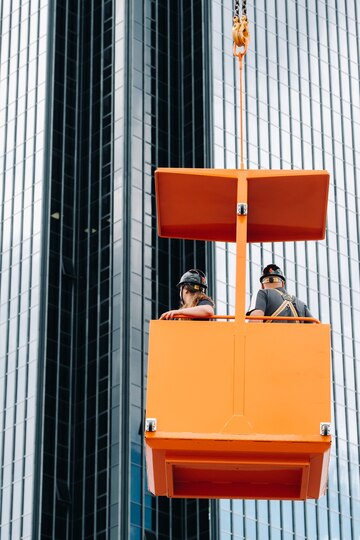Learn about the different types of hoists and their risk potential. Explore preventative measures to reduce accident risks, such as enhancing safety features, implementing regular maintenance protocols, and providing training programs. Choose reputable manufacturers like Apollo, known for their high-quality and customizable rope electric hoists that prioritize safety and efficiency.
Factors Contributing to Rope Electric Hoist Accidents
Design and Manufacturing Defects
The design and manufacturing process of a rope electric hoist plays a critical role in its safety. Poorly designed or manufactured hoists are more likely to fail under stress, leading to accidents. For instance, improper surface treatment can lead to corrosion over time, compromising the integrity of the equipment.
Improper Installation and Maintenance
Improper installation is another significant factor contributing to accidents involving rope electric hoists. Even a well-designed hoist can become dangerous if not installed according to the manufacturer’s specifications. Additionally, neglecting regular maintenance further exacerbates risks. Customized maintenance protocols and surface treatments like electroplating or oxidation can extend the lifespan of a hoist and improve operational safety. Failure to adhere to these practices often leads to wear-and-tear issues that could have been prevented.
Operator Errors
Mistakes made by humans continue to be a leading factor in accidents with rope hoists as they may result from inadequate training or incorrect handling methods that cause overloading or inappropriate use of the machinery. Operators must receive training in utilizing specialized functions like frequency conversion and two-speed capabilities. Without this knowledge, even the most sophisticated hoists can be, at risk of being used improperly.
Types of Rope Electric Hoists with Higher Risk Potential
Older Models vs. Modern Designs
Older versions of electric rope hoists are often at risk for accidents because they have outdated safety features and less durable materials, which is a concern for user safety and equipment longevity Modern hoist designs now include improved safety features such as overload protection systems and enhanced braking systems to enhance user protection and efficiency levels with material customization options like T80 or T100 chains that provide durability, than earlier models prompting users to assess if their current equipment meets present-day safety requirements.
Preventative Measures to Reduce Accident Risks
Enhancing Safety Features
Boosting the safety features of your rope hoist is essential to reduce potential hazards effectively. Customizing functions like being explosion-proof, dust-proof, and rain-proof provide defense against environmental dangers. Additionally integrating conversion technology guarantees a smoother performance even with different load circumstances.
Regular Maintenance Protocols
Establishing a maintenance routine is essential to guarantee the long-term safety and dependability of equipment and machinery systems. Utilizing surface treatments such as spray painting or nickel plating serves to safeguard against corrosion preserving the integrity of the equipment over time. Routine inspections should prioritize detecting signs of wear and tear to prevent them from developing into significant concerns, down the line.
Training Programs for Safe Operation
Training operators is crucial in reducing accidents with rope hoists since it helps them learn safe handling methods and how to use advanced features, like two-speed operations effectively while also preparing them for emergencies ahead of time.
Apollo provides a variety of customizable rope electric hoists that prioritize safety and efficiency in their design considerations. Whether you require explosion-proof variants or specialized surface finishes such as electroplating or oxidation treatments specifically tailored to your needs and adherent, to high-quality standards. Apollo delivers solutions that are personalized to meet your requirements.

Industry Standards and Compliance for Safety Assurance
Regulatory Bodies and Guidelines
Ensuring the safety of rope electric hoists requires adherence to industry standards and regulatory guidelines. These standards are established by recognized regulatory bodies that oversee the manufacturing, installation, and operation of lifting equipment. Compliance with these guidelines ensures that the equipment meets minimum safety requirements, reducing the likelihood of accidents. For example, regulations often mandate specific material properties for components like chains, such as customized chain T80 or T100, to ensure durability under high-stress conditions. Additionally, voltage customization options ranging from single-phase to three-phase 110V-575V are often stipulated to accommodate diverse operational environments safely.
Role of Certifications in Ensuring Product Safety
Certifications are crucial for ensuring the safety and dependability of electric rope hoists by verifying their quality through testing processes. Products that have been certified are less likely to experience failures during use. Certifications typically encompass factors such as explosion resistance and protection against dust and rain. These attributes are essential for hoists utilized in demanding settings where they face environmental conditions. Additionally following surface treatments like painting, electroplating, or oxidation that meet certification requirements can offer safeguards, against wear and rust. Using certified products doesn’t just improve safety during operations. Also gives users peace of mind, about how well they’ll perform in the long run.
Conclusion: Selecting the Right Rope Electric Hoist for Safety Assurance
Evaluating Safety Features Before Purchase
When choosing a rope hoist it’s important to thoroughly assess its safety features. Be sure to check for customized functions like frequency conversion two-speed operations that meet application requirements and improve overall safety. Take a look at the materials used in its construction; for example, chains with galvanized or nickel-plated finishes provide better resistance to environmental elements compared to untreated materials. Also think about whether the hoist is equipped with advanced braking systems or overload protection features as these are crucial, in preventing accidents while in use.
Importance of Choosing Reputable Manufacturers like Apollo
When selecting a maker for your electric hoist with rope is crucial to ensure its safety and reliability factors are top-notch. Established manufacturers focus on maintaining quality control standards throughout the design and manufacturing processes. Take Apollo for example – they excel in providing solutions that cater to specific operational needs to guarantee all their products meet strict safety regulations. Their wide selection includes choices for customizing appearance (color and logo) adjusting voltage (110v. 575V) and applying surface finishes such, as oxidation or electroplating. Opt for suppliers dedicated to providing products to reduce the chances of using inferior equipment and maximize efficiency in your specific use case.

